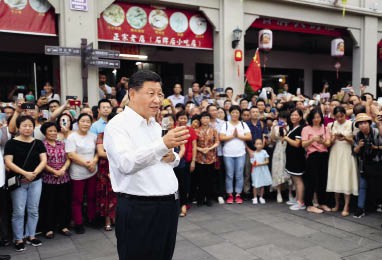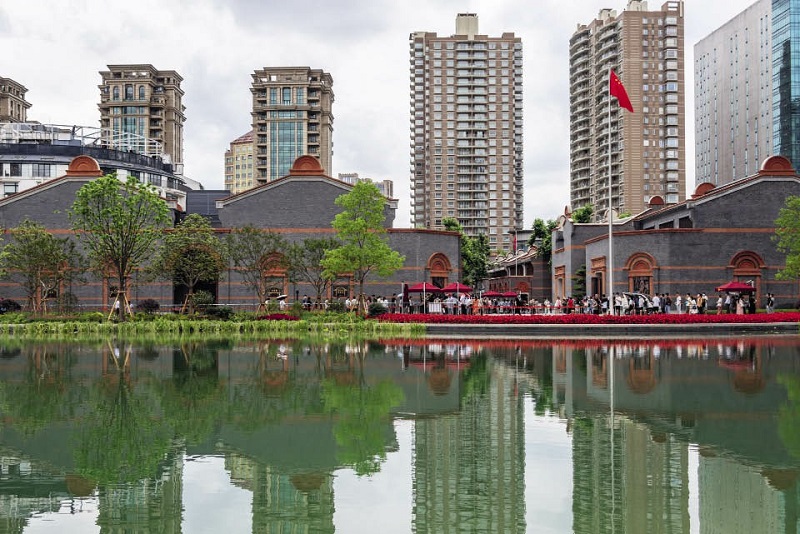The Communist Party of China (CPC) has every reason to take great pride in its historic accomplishments on the occasion of its 100th anniversary. Beginning in 1921, despite the low number of individuals who were intent on pulling China out of the chaos following the downfall of the Qing Dynasty (1644-1911), while at the same time being hounded by the then authorities who suppressed everything that had a communist label, the leaders of the CPC had not been diverted from their mission, namely, improving the people’s livelihood and accomplishing the rejuvenation of the Chinese nation from the previous “century of humiliation.”

President Xi Jinping speaks with people during a visit to a street lined with ancient memorial archways in Chaozhou, south China’s Guangdong Province, on October 12, 2020.
When excluded from positions of influence by the Nationalist Party of China, known as Kuomintang (KMT) in China, with which it had been in alliance, and chased out of its political base in Jiangxi Province by the army of Chiang Kai-shek (leader of the KMT) in 1934, the Red Army led by the CPC proceeded on its 7,800-mile “Long March” to a safe mountainous area in Shaanxi Province in northwestern China, an achievement unprecedented in military history. From there, the Party began their war of resistance against Japanese aggression long before the KMT government showed any will to resist.
With their limited supply of heavy arms but strong support from the people, the CPC led a successful campaign of guerrilla warfare against the Japanese forces. Their success was attested to by many visitors, including Americans like journalists Edgar Snow and Anna Louise Strong, and U.S. Marine Major Corps general officer Evans Carlson, who visited them.
Only later – and under duress – would Chiang Kai-shek decide to take up arms against Japan. The success of the CPC-led forces was primarily due to the Party’s commitment to improve the lot of the rural population, a hallmark of the Party. Unlike the armies of the war lords or even the KMT army, the CPC-led Chinese Workers’ and Peasants’ Red Army (Red Army in short) soldiers maintained the highest respect for people in the villages, the actual people for whom they were fighting. And this was reciprocated by the people who aided them in their fight.
With the victory over the forces of the KMT during the civil war, and the establishment of the People’s Republic of China (PRC) in 1949, the CPC assumed responsibility for a country of a half billion people, a daunting task indeed. Here too they won the support of the people in carrying out the difficult task of uniting and developing the country after years of wars against foreign invaders and the civil war.
While the PRC had many friends from the beginning, they also had powerful enemies. The United States, in particular, which had supported the KMT during the civil war, instead of accepting the new reality of China being led by the CPC, proceeded to treat the PRC as a hostile force, and began to conduct subversive operations against it, insisting that Chiang Kai-shek, ensconced on the island of Taiwan, was still the formal head of China. Former U.S. “China hands” in the State Department and the Pentagon who urged a different policy, were quickly muzzled or fired in the atmosphere of hysteria created by Senator Joe McCarthy and his cohorts.
In the midst of trying to increase grain production to feed the growing population, the CPC supported the development of scientific work, which was not only vital for national defense, but also for long-term economic development. When China’s rocket scientist Qian Xuesen returned to China from the U.S. during the McCarthy era, he went to work to help deve-lop Chinese space technology. He worked with other scientists under very difficult economic conditions to carry out the “two bombs, one satellite” program, through which China would become a nuclear power and which would lay the basis for China to become a space power.
With the commencement of the country’s reform and opening-up in 1978, there was a renewed emphasis on science and technology. As a result of the reform and opening-up, China became the manufacturing center of the world. At the same time, it was also preparing to “leap-frog” onto the stage of “high-value” production. Key to this was the rapid development of science and technology.
As China’s coastal regions developed rapidly, the Party also gave priority to the hundreds of millions of people still living in poverty in the central and western parts of the country. The policy of developing the country’s western region in the late 1990s represented a clear commitment by the Party to bring prosperity to the outlying regions – and tackle the still serious problem of extreme poverty existing in those regions.
As China’s western development policy proceeded, it also became clear that it had an international dimension. With the break-up of the former Soviet Union at the end of 1991, China found itself with new countries on its border, countries which were land-locked and isolated from the mainstream of international commerce. But with the expansion of rail lines in Gansu and Xinjiang, it became clear that these countries could be easily linked to rail connections in Central Asia and Russia. One line had already been established for what was called the New Eurasian Landbridge, a line that ran from Rotterdam in the Netherlands to Lianyungang on the east coast of China.
As the world passed through two major financial crises, the Asian financial crisis of 1997 and the global financial meltdown in 2008, during which China played a major role in stabilizing the world economy, this route remained a singular accomplishment in East-West connectivity. But with the improvement in the economy and the beginning of the new era, the situation saw marked changes. In September 2013, Chinese President Xi Jinping announced the conception for jointly developing the Silk Road Economic Belt through Central Asia in Kazakhstan. Then in October of the same year in Indonesia, he announced plans for developing the 21st Century Maritime Silk Road. The Belt and Road Initiative (BRI), as it would later be called, changed the direction of world economic development.

Crowds of citizens line up to enter the Memorial for the Site of the First National Congress of the CPC in Shanghai on June 8, 2021.
By the beginning of this century, there was no great impetus for any major development policy on a global level. The international financial institutions had abandoned any thought of great economic projects that could catapult developing countries into a new level of development. The best they could do was trying to keep everything going at an even keel, work to allow developing countries to continue paying back their past debts, and minimize poverty so as to prevent people from thinking that they were completely oblivious to the problem. In the same way, international lenders simply did not find development projects as profitable as they had speculated, not being able to make quick profits.
It was in this malaise that the 2008 economic crash occurred. While investment in real production had been on the decline, financial speculation had been booming – then the market crashed. The BRI changed everything quickly. Major investment in railroads in Southeast Asia, Africa, and Latin America suddenly became a going concern. With its new-found economic might, China was in a position to conduct major investment projects and was committed to doing them. What China accomplished in raising itself up out of an impoverished state has become a paradigm for other countries to follow. The BRI put infrastructure investment and global development firmly back on the table. This in itself was a historic achievement. The tide of history had turned – back in the direction of world development, thanks to the commitment of the CPC in launching such a project.
But this was not the end of the historical firsts accomplished by CPC. The success of China’s poverty reduction program and elimination of absolute poverty throughout the country was undoubtedly an unprecedented historical achievement of its kind for any country – and it reached this goal with a population of 1.4 billion people. The results of this move surpassed everyone’s wildest dreams – and it drew a line in the sand for other countries. If China, with its huge population could achieve such a result, other countries with much smaller populations could and should do the same.
It is not certain that other countries will really follow suit in this direction. There is a certain amount of resentment among some in the West over the fact that China under the leadership of the CPC has accomplished what the combined Western nations, led by the United States, were incapable of doing, not so much from a lack of technical means, but more from a lack of political will. Much of the reaction to China’s success from some Western countries has been nothing less than sour grapes – and exceedingly dangerous. The rest of the world, on the other hand, and in particular the developing countries, have seen the benefits of these projects and have rallied around China. Even many of the Western countries have begun to see the U.S. administration’s attempt to antagonize China for its success as extremely petty and counterproductive. While the decisions are still out as to whether the U.S. and China will find a working relationship that benefits mankind, the accomplishments of the CPC stand on their own, and are worthy of great celebration during this 100th anniversary year of the CPC, not only in China, but in the rest of the world as well.
WILLIAM JONES is a Washington policy analyst and a non-resident fellow of the Chongyang Institute for Financial Studies under Renmin University of China.